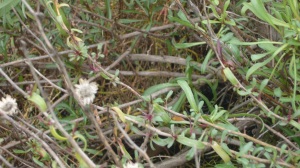One of the things we love to do here is birdwatch and we do it with some frequency. I first heard about birding as a serious thing that real people did back in college from a friend, who since walked across Cuba and wrote a great book about it (in which the birding bits are among the best). He’s traveled all over the world for work and birding, and you should read his blog, which these days is full of urgent, important information on Haiti, where he has spent a goodly amount time.
We’re lucky enough to have a superb wetlands preserve near our house that is home to numerous species of birds. Some are migratory, some make their home year round.Some are common, some are very rare and draw birders from many miles around. There’s an amazing hatchery/nesting ground for blue herons, and Snowy Egrets are so common that the kids are no longer startled to see one of these beautiful creatures. It’s an amazing place to take the kids, and each trip reveals something different.
We are not experts at birdwatching, and we do it in a kind of haphazard way. We don’t always (often?) even know what we’re looking, but we’ve found that birders can be a friendly lot, and are eager to name or point out new species or give us advice, especially when they realize we’re are serious as one can be with a 5 & 7 year old, and always respectful.
For some years now, we’ve been trying to see a Clapper Rail, an endangered and elusive bird that makes its home in the pickelweed of these wetlands. It has eluded us, trip after trip. But on our last visit we saw something nearly as good: the Virginia Rail. Over the space of 2 hours, we spotted 3 (three!) darting in and out of the weeds and grasses at the edge of the path at high tide. They were very quick and very well-camouflaged, which made it all the more satisfying. Ella, who has been the one driving our mission for 2+ years now was thrilled and snapped this picture. If you look very closely, you can see the rail’s orange beak hidden in the dark patch at the bottom of the frame.
 really, it’s there, the Virginia Rail
really, it’s there, the Virginia Rail
And then we got a great look at a hawk, that might just be the opposite of the Rail in terms of obviousness.
And what, you are wondering by now, does birding and the Virginia Rail and 7-year-old’s birding life list have to do with Raising Generation O?
Exactly this, from Rachel Carson:
The pleasures, the values of contact with the natural world, are not reserved for scientists. They are available to anyone who will place himself under the influence of a lonely mountain top–or the sea–or the stillness of a forest; or who will stop to think about so small a thing as the mystery of a growing seed. I am not afraid of being thought a sentimentalist when I stand here tonight and tell you that I believe natural beauty has a necessary place in the spiritual development of any individual or any society. I believe that whenever we destroy beauty, or whenever we substitute something man-made and artificial for a natural feature of the earth, we have retarded some part of man’s spiritual growth.
Or, I would add, the elusive, playful, mysterious nature of a Rail. When we take our kids “birding” they absorb something elemental about their world, and they begin to understand and observe that habitat change, tides influence land and animals. They begin to see that they share the earth with many, fragile species. They know first hand just what endangered means. They are forced to slow down and to look closely, on their bellies, and wait and wait and watch and listen and see how the world is alive in so very many ways. They move deeper toward an understanding of natural beauty and order.
Carson wrote, presciently, in the middle of last century:
For there is symbolic as well as actual beauty in the migration of birds; in the ebb and flow of the tides; in the folded bud ready for spring. THere is something infinitely healing in these repeated refrains of nature–the assurance that dawn comes after night, and spring after winter.
Mankind has gone very far into an artificial world of his own creation. He has sought to insulate himself, with steel and concrete, from the realities of earth and water. … For this unhappy trend there is no single remedy–no panacea.
But turning off the screens, and getting out of the house and looking at a few birds. Well, that’s definitely a start.
Filed under: birding, education, science | Tagged: birding with kids, Rachel Carson, Virginia Rail | Leave a comment »



